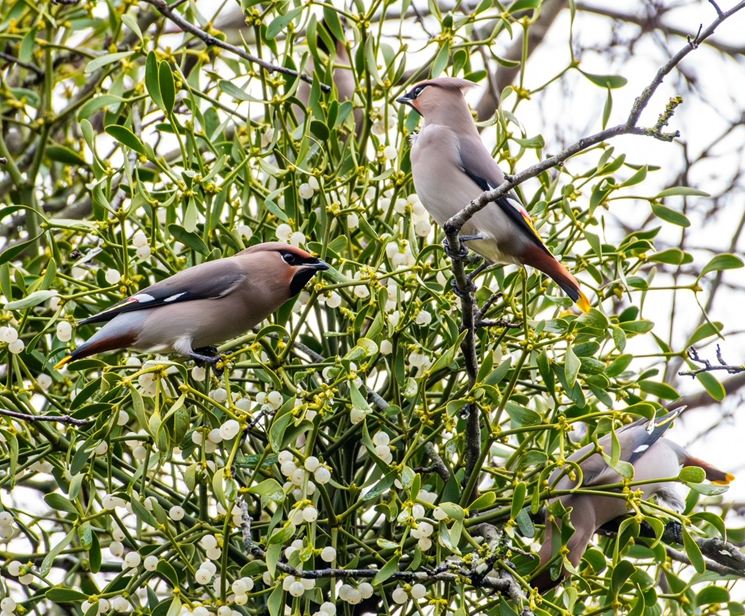Biometrics and movements of Redwings ringed in
Grampian 1989 – 2024
(Innes Sim)
Figure 1 shows the distribution in wing length, with a mean of 119 mm
and a range of 106 – 131 mm. There was no significant difference in mean wing
length between the three age classes; first-year (119.1 ± 3.1 s.d., n = 438),
adult (119.7 ± 3.2, n = 240), unknown age birds (119.7 ± 3.5, n = 18) (ANOVA F
= 2.11, d.f. = 2, 696, P = 0.12). There was, however, a marginally significant
difference in mean wing length between the 3 months: Oct (119.7 ± 3.3, n =
364), Nov (119.2 ± 3.2, n = 100), Dec (118.9 ± 3.1, n = 198) (ANOVA F = 3.40,
d.f. = 2, 659, P = 0.03). Mean wing length apparently decreased during the 3
months, but the difference of 0.8 mm was small and well within the measurement
accuracy and range of measurement error of different ringers (1 – 2 mm). Hence,
we conclude that there was no difference in mean wing length, and thus
approximate body size, in birds in different age classes or months.
These wing lengths are very similar to a larger sample
from the BTO (https://www.bto.org/understanding-birds/birdfacts/redwing).
Unfortunately, it is not possible to sex Redwings in the hand but it appears
that males have mean wing lengths around 7 mm longer than females (males 122
mm, females 115 mm; https://www.bto.org/understanding-birds/birdfacts/redwing).
Figure 1. Histogram of wing length distribution of 699 Redwings measured
in Grampian 1989 - 2024.
Body weight
There was no significant difference in mean body weight between age
classes (ANOVA F = 2.40, d.f. = 2, 521, P = 0.09), so data from all age classes
were combined. Mean body weight increased significantly between Oct and Dec;
Oct (62.7, ± 5.6 s.d.), Nov (65.5 ± 5.1), Dec (72.6 ± 6.1) (ANOVA F = 158.68,
d.f. = 2, 521, P < 0.001; Figure 2).
Surprisingly, we could find only one published scientific
paper on Redwing biometrics in autumn, and none on how these change between months.
Mean body weight of birds killed when flying into Bardsey Lighthouse, North
Wales, in October 1995 was around 62 g, so very similar to our values in
October (https://nsojournals.onlinelibrary.wiley.com/doi/epdf/10.1034/j.1600-048X.2000.310211.x).
Figure 2. Mean (± 95% C.L.) body weight of Redwings measured during October
to December 1989 – 2024.
Why is there an increase in body weight between October and December?
First, we can rule out the possibility that birds arriving in Grampian
in November and/or December are simply larger than those in October, since
there was no increase in wing length during these three months. The Icelandic
race (Turdus iliacus coburni) is longer-winged and presumably heavier
than the nominate race (T. i. iliacus), which breeds in northern Europe
(https://britishbirds.co.uk/journal/article/status-and-identification-icelandic-redwing-britain), so it seems
very unlikely that an influx of Icelandic birds can account for the increase in
body weight. We do, however, catch a small but unknown proportion of Icelandic
birds in Grampian (Figure 3). A more likely explanation for the increase in
body weight is that birds arriving in October, having just undergone a taxing
migration across the North Sea from northern Europe, or the Atlantic from
Iceland, are in relatively poor body condition. They then increase their body
condition as they feed on invertebrates and/or berries, such that by December
they have increased their body weight by around 10 g (16%) on average. The
origin of autumn migrants in the UK remains obscure but it is thought that many
birds subsequently move south to winter in France and Iberia, especially during
winters when weather is harsh and berry crops are poor in the UK (https://www.tandfonline.com/doi/abs/10.1080/03078698.2002.9674271). An increase
in body weight would allow birds to perform this extra migration leg
successfully, as well as helping to cope with harsher winters for those that
choose to remain in Scotland.
Figure 3. Icelandic (top) and Nominate (bottom) Redwing races trapped in
Grampian in December 2024.
Origins of Redwings arriving in Grampian in autumn
There have been only three recoveries of birds to/from Grampian out of
701 ringed during the last 35 years! However, around 250 of these were ringed
in 2024 so the recovery rate excluding these is around 1 in 150. Birds ringed
in northern Norway and Fair Isle, Scotland, in October were controlled in Grampian
in November, while another was shot in Portugal in December having been ringed
in Grampian in October. All three were ringed as fully-grown birds and we
therefore have no idea as to where their natal areas were. It seems likely that
the majority of birds arriving in Grampian in autumn originate in Fennoscandia,
although smaller numbers may be from in Iceland (https://migrationatlas.org/node/1782#section1). Numbers in
Grampian appear to peak around November and then fall off sharply, presumably
as birds make their way further south and west in search of food (especially
berry) sources. It seems likely that many of these birds continue south to winter
in southern France and Iberia (https://migrationatlas.org/node/1782#section1), although we
currently have only a single ringing recovery to back that up.
We currently have a very poor understanding as to the origins of
Redwings passing through in autumn and wintering in Grampian, and should
attempt to increase numbers ringed by targeting favoured foraging and roosting
areas. It would also be interesting to identify the proportion of birds of
Icelandic origin in Grampian in autumn and winter, following the guidelines
identified in a recent paper (https://britishbirds.co.uk/journal/article/status-and-identification-icelandic-redwing-britain). Perhaps through
implementing these two measures we can increase our knowledge of the origins
and movements of this attractive, elusive and shy, but fascinating thrush.













































